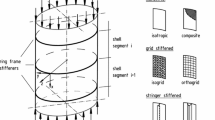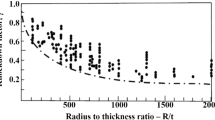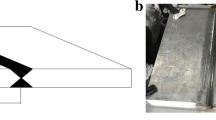A high competition level in modern space-rocket technology requires continuous improvement of structural elements and enhancement of their reliability, on the other hand, reduction in production costs and lead times. One of the pressing problems of national rocket engineering is to hold down the number of physical tests (especially destructive) of the samples and replace them with computational methods. The first consideration in efficiently designing space-rocket power structures, such as propellant tanks, high-pressure cylinders, etc., is to increase the net volume of the structure and cut down its materials consumption without losing strength properties. Various engineering designs are employed to enhance the reliability and strength of such structures: end and intermediate rib stiffening, variable shell thickness, etc. The new model of a bimetallic waffle-skin shell of a launch vehicle propellant tank, made of an aluminum alloy and strengthened with a titanium skin, is advanced. The finite element method-based software was used to perform its 3D stress-strain state computations. The results for bimetallic shell computations showed that a titanium skin was liable to elastic strains that do not exceed 0.54 %, and maximum equivalent strains of an aluminum alloy reached about 0.7 %, while equivalent elastic strains were approximately half as much. Computational studies confirmed that the bimetallic shell of a lower weight exhibited insignificant plastic strains compared to the conventional waffle-skin design. Moreover, the thickness of an aluminum alloy sheet for shell fabrication is reduced by more than half; thus, the shell alternative as a double-layer structure can be employed to advantage. The computational results can be used to design new space-rocket structural elements and assess their stress-strain state.







Similar content being viewed by others
References
V. S. Hudramovich, V. N. Sirenko, D. V. Klimenko, et al., “Development of the normative framework methodology for justifying the residual resource of starting buildings’ constructions of space launch vehicles,” Strength Mater, 51, No. 3, 333-340 (2019). https://doi.org/10.1007/s11223-019-00079-4
A. S. Konyukhov, A. S. Tsybenko, and A. A. Rybalka, “A study of the dynamic characteristics of the Cyclone-4 launch vehicle on the basis of a continuum rod model,” Strength Mater, 47, No. 4, 532-535 (2015). https://doi.org/10.1007/s11223-015-9686-3
L. V. Kravchuk, K. P. Buiskikh, I. I. Derevyanko, and O. M. Potapov, “Load-bearing capacity of elements of composite shell structures in rocket and space engineering made of composite materials,” Strength Mater, 54, No. 4, 613-621 (2022). https://doi.org/10.1007/s11223-022-00439-7
P. Gontarovskyi, N. Smetankina, N. Garmash, and I. Melezhyk, “Numerical analysis of stress-strain state of fuel tanks of launch vehicles in 3D formulation,” in: M. Nechyporuk, V. Pavlikov, and D. Kritskiy (Eds.), Integrated Computer Technologies in Mechanical Engineering - 2020, Vol. 188, Springer, Cham (2021), pp. 609-619. https://doi.org/10.1007/978-3-030-66717-7_52
D. V. Akimov, V. Z. Gryshchak, S. I. Gomenyuk, et al., “Finite-element analysis and experimental investigation on the strength of a three-layer honeycomb sandwich structure of the spacecraft adapter module,” Strength Mater, 48, No. 3, 379-383 (2016). https://doi.org/10.1007/s11223-016-9775-y
A. Kubit, T. Trzepiecinski, L. Swiech, et al., “Experimental and numerical investigations of thin-walled stringer-stiffened panels welded with RFSSW technology under uniaxial compression,” Materials, 12, No. 11, 1785 (2019). https://doi.org/10.3390/ma12111785
C. H. Sim, G. S. Kim, D. G. Kim, et al., “Experimental and computational modal analyses for launch vehicle models considering liquid propellant and flange joints,” Int J Aerospace Eng, 4865010 (2018). https://doi.org/10.1155/2018/4865010
D. V. Akimov, V. Z. Grishchak, I. F. Larionov, et al., “Software for strength analysis of space-rocket power elements” [in Russian], Probl Vych Mekh Proch Konstr, 26, 5-21 (2017).
A. N. Shupikov, S. V. Ugrimov, A. V. Kolodiazhny, and V. G. Yareschenko, “High-order theory of multilayer plates. The impact problem,” Int J Solid Struct, 35, No. 25, 3391-3403 (1998). https://doi.org/10.1016/S0020-7683(98)00020-1
S. V. Ugrimov, “Calculation of three-layer plates with composite skins” [in Russian], Vopr Proekt Proiz Konstr Let Apparat, 3, 47-56 (2014).
S. Ugrimov, N. Smetankina, O. Kravchenko, et al., “A study of the dynamic response of materials and multilayer structures to shock loads,” in: H. Altenbach, A. H.-D. Cheng, X.-W. Gao, et al. (Eds.) Advances in Mechanical and Power Engineering. CAMPE 2021, Springer, Cham (2022), pp. 304-313. https://doi.org/10.1007/978-3-031-18487-1_31
P. Gontarovskyi, N. Garmash, and I. Melezhyk, “Numerical modeling of dynamic processes of elastic-plastic deformation of axisymmetric structures,” in: H. Altenbach, A. H.-D. Cheng, X.-W. Gao, et al. (Eds.) Advances in Mechanical and Power Engineering. CAMPE 2021, Springer, Cham (2022), pp. 334-342. https://doi.org/10.1007/978-3-031-18487-1_34
K. Washizu, Variational Methods in Elasticity and Plasticity, Pergamon Press, Oxford–New York (1982).
K. J. Bathe and E. L. Wilson, Numerical Methods in Finite Element Analysis, Prentice-Hall, Englewood Cliffs, NJ (1976).
R. H. Gallagher, Finite Element Analysis: Fundamentals, Pearson College Div (1975).
O. C. Zienkiewicz and K. Morgan, Finite Elements and Approximation, Wiley, New York (1983).
L. Segerlind, Applied Finite Element Analysis, John Wiley & Sons, New York–London–Sydney–Toronto (1976).
H. G. Shulzhenko, P. P. Gontarovsky, Y. I. Matyukhin, and N. G. Garmash, “Kinetics simulation of three-dimensional thermomechanical fields in turbomachine elements” [in Russian], Vibr Tekn Tekhnol, 38, No. 6, 26-30 (2004).
P. Gontarovskyi, N. Smetankina, N. Garmash, and I. Melezhyk, “Analysis of crack growth in the wall of an electrolyser compartment,” J Mech Eng – Problemy Mashynobuduvannia, 23, No. 4, 38-44 (2020). https://doi.org/10.15407/pmach2020.04.038
S. Alyokhina, A. Kostikov, N. Smetankina, et al., “Methodology for determining the thermal and thermal-stress states of a concrete storage container for spent nuclear fuel for assessment of its service life,” Nuclear Radiation Safety, 4, No. 92, 33-39 (2021). https://doi.org/10.32918/nrs.2021.4(92).05
P. P. Hontarovsky, N. V. Smetankina, S. V. Ugrimov, et al., “Simulation of the crack resistance of ion-exchange strengthened silicate glass subject to bending strain,” Int Appl Mech, 58, No. 6, 715-724 (2022). https://doi.org/10.1007/s10778-023-01195-0
N. G. Shul’zhenko, P. P. Gontarovskii, Y. I. Matyukhin, and N. G. Garmash, “Numerical analysis of the long-term strength of the rotor disks of steam turbines,” Strength Mater, 42, No. 4, 418-425 (2010). https://doi.org/10.1007/s11223-010-9232-2
P. P. Hontarovsky, N. V. Smetankina, S. V. Ugrimov, et al., “Numerical investigations of the crack resistance of ion exchange strengthened sheet glass under flexural deformations,” J Mech Eng – Problemy Mashynobuduvannia, 24, No. 3, 45-51 (2021). https://doi.org/10.15407/pmach2021.03.027
I. A. Birger, B. F. Schorr, I. V. Diamianushko, et al., Thermal Strength of Machine Elements [in Russian], Mashinostroenie, Moscow (1975).
Author information
Authors and Affiliations
Corresponding author
Additional information
Translated from Problemy Mitsnosti, No. 5, pp. 49 – 62, September – October, 2023.
Rights and permissions
Springer Nature or its licensor (e.g. a society or other partner) holds exclusive rights to this article under a publishing agreement with the author(s) or other rightsholder(s); author self-archiving of the accepted manuscript version of this article is solely governed by the terms of such publishing agreement and applicable law.
About this article
Cite this article
Gontarovskyi, P.P., Smetankina, N.V., Garmash, N.G. et al. Three-Dimensional Stress-Strain State Analysis of the Bimetallic Launch Vehicle Propellant Tank Shell. Strength Mater 55, 916–926 (2023). https://doi.org/10.1007/s11223-023-00582-9
Received:
Published:
Issue Date:
DOI: https://doi.org/10.1007/s11223-023-00582-9




